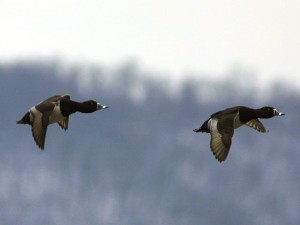The first hard push of the migration began this past week as temperatures took a significant dive across the Canadian Provinces. From Oregon to Eastern Michigan, duck numbers have increased rapidly as green-winged teal, gadwall, widgeon, bufflehead, ringed-necks and ruddy ducks begin to hop-scotch down the flyway.
Hello folks, and, as always, welcome to Waterfowler.com.
Migration activity is heating up as temperatures took a dive in Canada and the U.S. Prairie Pothole Region last week. The leading edge of the migration saw rafts of ruddy ducks moving across the Great Lakes Region with a surge of green-winged teal, gadwall and bufflehead moving close behind. Hunters in the drought plagued Central and Mississippi Flyways are reporting record sized-flights along the major river systems and large bodies of water.
While diver shooting is good to excellent on big lakes in the northern states, puddle duck shooting is best in nearby fields and along the rivers where these ducks are searching for food.
Goose numbers and hunting remains good to excellent in northern states, as the numbers have continued to build and field hunting is excellent at this time.
Favorable migrating winds are expected to continue throughout most of the week and move birds quickly down the flyways. As the saying goes, “get while the getting is good.” If there was a time to burn a sick day or vacation day in the northern third of the nation to hunt ducks, this is the week.
While harsh weather is known for moving ducks and attracting duck hunters, we hope that hunters in north eastern states, in the path of hurricane Sandy, choose caution and good sense over the next few days – even if hunting hundreds of miles inland. Gusting winds can easily swamp and capsize boats along the fringes of this storm system – the ducks will be there after the storm passes. So please, hunt safe.
PACIFIC FLYWAY:
Migration activity has increased dramatically in Washington, Oregon, Idaho and Montana. Mallard numbers in Idaho and Western Montana sky-rocketed over the past 5-days and hunter success is good to excellent throughout the northeastern portion of the flyway. In Utah, mallard numbers as slowly climbing with Gadwall and Widgeon good. Duck numbers in the Sacramento Valley remain low for this time of year with goose numbers fair.
CENTRAL FLYWAY:
It’s “go time” in the northern portion of the flyway with duck numbers in the Dakotas soaring over the past week. With ice in smaller marshes, flock sizes are increasing on larger potholes with open water. Snow goose numbers are climbing throughout North Dakota with mallard numbers good and increasing. Diver numbers are good to excellent in the northern third of the flyway with ringed-neck ducks and bufflehead providing excellent action. Teal numbers remain good to excellent in the lower third of the flyway – with gadwall and pintail numbers fair from the panhandle to the Gulf coast.
MISSISSIPPI FLYWAY:
The mid-season lull in the far north has been replaced by a migration flurry. Hunter success in Minnesota, Wisconsin, Iowa and northern Illinois is good to excellent at this time along the major river systems and large bodies of water holding ducks. Green-winged teal have been reported in record numbers along the upper Mississippi Flyway with diver numbers good to excellent on bufflehead, ringed necks, ruddy ducks and hooded mergansers. Gadwall and widgeon numbers are increasing with mallards fair. Wood ducks are still present in northern states but many have pushed south over the past week.
ALTLANTIC FLYWAY:
Waterfowler.com extends our concerns for those in the path of hurricane Sandy and reminds those heading to the field along the fringe edges of the system to exercise extreme caution. The cold front that is clashing with the inbound hurricane has brought a significant number of new ducks and geese to the upper third of the flyway. Canada goose numbers are good to excellent in Ohio and Pennsylvania, with diver numbers increasing as those appearing in the Great Lakes work their way east. Rafts of ruddy ducks are moving towards the Chesapeake Bay with bufflehead and ringed-neck numbers increasing behind them. Prior to the storm, wood duck numbers were still good to excellent throughout the New England states with teal numbers decreasing as the birds moved south.
Until our next report, hunt safe, hunt often and be sure to vote next week.






